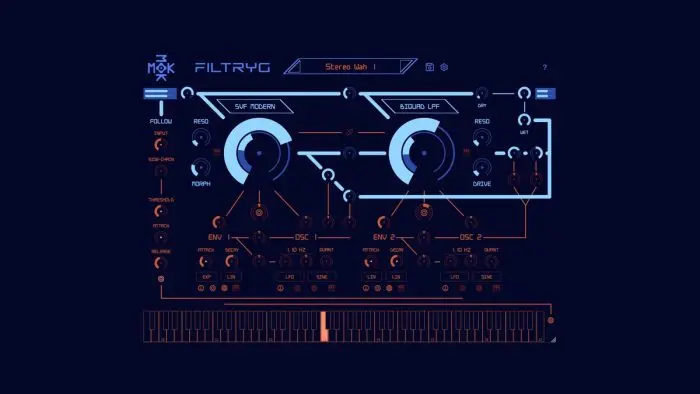Regular contributor Velislav has a soft spot for filters. In this review he takes a look at MOK’s creative dual filter effect Filtryg.
What does Filtryg by MOK do? Where to use it?
The universal value of filters for modern music could be explained this way – Imagine the filter as a master DJ, who can play and stop the music, who can mix anything, who can take any part from any source and lift the crowd in front to the sky with excitement. The filters are masters of the party. A combination of two filters in serial mode (connected one after another) is double the power. This is what Filtryg by MOK offers.
But what is so special about what filters do exactly? Is it the polishing, is it the excitement?
Properly used, a filter is a game changer every time. Your mix sounds dull, put right filter preset and voila it becomes something amazing. Your synth presets are nice, but in the mix they sounds wrong? Put the right filter preset on top and you immediately have totally different sonic characteristics and presence in the mix. The entire mix becomes new and interesting, using a quality filter such as Filtryg. The advance mixing starts when a user realizes that when moving the filter up and down across right areas, it gives the track sweetness and dynamics no other fx can deliver. This is just the beginning of the filter’s story :)
Modern science hasn’t even started to understand the influence of acoustics to human perceptions. With the right filter presets you can create a huge impact on your audience, to make them feel happy or sad, thrilled or relaxed…
A filter opens the sound frequencies from 0 to 100 across entire audible spectrum and when you have a favourite frequency area, lets say from 250 to 350 Hz, the resonance is what will accent and amplify these frequencies by making other frequencies fade, and filter movement can make any track shine like a star.
Filtryg, what are its super powers?
Probably one of the best available on the market, this plugin has super quality filters. It allows you to morph from low pass via band pass to high pass, which means you can combine different sonic areas with filters in different modes, to squeeze and shape the right sound. Each of the filter types of Filtryg provides a different character and will behave differently, adding unique sonic flavor.
- Left filters: SVF (classic and modern options) or State Variable Filter, which is going to give you solid, expressive, bright sound. The knobs under each filter control the shape, speed, attack and morph between types so you can adjust the movement and flavour of the filter according to your project needs. You can sync or make them move independently for more dynamics.
- Right filters: Ladder and Biquad. Ladder filter is probably the most famous classic filter, it is used in Moog synthesizes. It is famous for its silky smooth sound, used in countless records and many producers still prefer it. Be careful with its resonance, because it’s very predictable and may produce wild harmonic distortion. Biquad filter is a clean filter, pefect for modern experimental styles.
I personally mostly use serial mode, where filters are connected and add their character and swing one after another. Double flavour, double character, double movement, double excitement.
My final thoughts about Filtryg
The filters are amazing. Top notch quality, intuitive and inspirational to work with. Once you touch it, you will start using it on every track you need extra flavour and dynamics.
In the demo below you can feel how even a simple tremolo swing can make a pad sound dynamic.
Filtyg is available for Windows, Mac and Linux in VST/VST3, AU and AAX formats. Priced $39 USD, the plugin is sold at the MOK store and at distributor Plugin Boutique. A free 14-day trial version is available to try the plugin, and you can download Velislav’s tremolo preset from the demo here (.vstpreset format).



